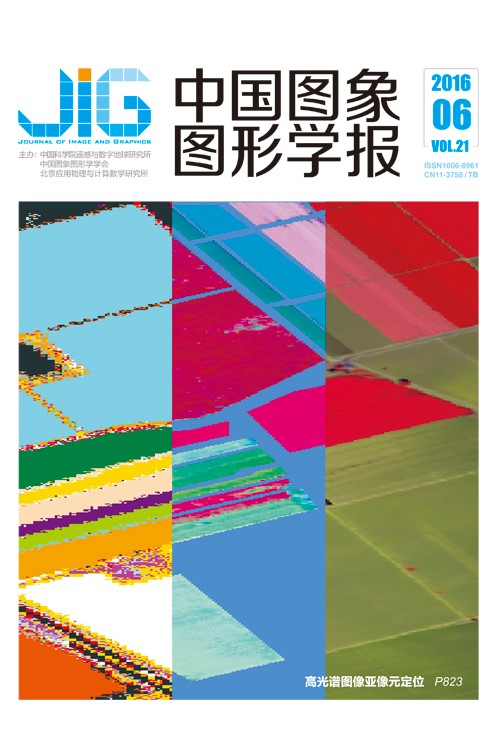
快速3维坐标变换的绘制算法
摘 要
目的 基于深度图的绘制(DIBR)是一种新型的虚拟视点生成技术,在诸多方面得到了广泛的应用。然而,该技术还不能满足实时性的绘制需求。为了在保证绘制质量不下降的前提下,尽可能地提高绘制速度,提出了一种高效的3D-Warping(3维坐标变换)算法。方法 主要在以下3个方面进行了改进:1)引入了深度—视差映射表技术,避免了重复地进行视差求取操作。2)对深度平坦的像素块进行基于块的3D-Warping,减少了映射的次数。对深度非平坦像素块中的像素点采取传统的基于像素点的3D-Warping,保证了映射的准确性。3)针对两种不同的3D-Warping方式,分别提出了相应的插值算法。在水平方向上,改进的像素插值算法对紧邻插值和Splatting(散射)插值算法进行了折中,只在映射像素点与待插值像素点很近的情况下才进行紧邻插值,否则进行Splatting插值;在深度方向上,它对Z-Buffer(深度缓存)技术进行了改进,舍弃了与前景物体太远的映射像素点,而对其他映射像素点按深度值进行加权操作。结果 实验结果表明,与标准绘制方案的整像素精度相比,绘制时间平均节省了72.05%;与标准绘制方案的半像素精度相比,PSNR平均提高了0.355dB,SSIM平均提高了0.00115。结论 改进算法非常适用于水平设置相机系统的DIBR技术中的整像素精度绘制,对包含大量深度平坦区域的视频序列效果明显,不但能够提高绘制的速度,而且可以有效地改善绘制的客观质量。
关键词
Fast 3D-warping algorithm for depth image based rendering
Wang Hui, Peng Zongju, Jiao Renzhi, Chen Fen, Yu Mei, Jiang Gangyi(Faculty of Information Science and Engineering, Ningbo University, Ningbo 315211, China) Abstract
Objective Free viewpoint video (FVV), an emerging 3D video technology, is currently gaining popularity. As its primary advantage, FVV allows audiences to enjoy the video service of an arbitrary visual angle and feel a vivid stereoscopic visual sense as though they are part of the scene they are watching. Depth image based rendering (DIBR), which can synthesize virtual views with the referenced views and associated depth information that are randomly located on terminal display devices, is a key FVV technology to generate 3D views. However, this technology cannot satisfy real-time needs, and the noise that appears in the synthesized images can lead to visual discomfort because of the imperfect depth maps. Given the poor objective and subjective qualities of the virtual views, this paper proposes a novel 3D-warping algorithm for DIBR to increase the rendering speed as much as possible. Method This study makes three main contributions. First, to reduce the computation time in 3D-warping, the mapped table for converting depth to parallax is introduced before the rendering. During the rendering process, the programs search the mapped table to obtain the parallax and to avoid repetitive operations. Second, the depth maps of the referenced views are divided into similarly sized square blocks. We adopt block-based 3D-warping, which requires only one instance of warping, if the pixels in the same block have the same depth. Otherwise, we employ the pixel-based 3D-warping, which must conduct warping one by one. The block-based 3D-warping saves much time in decreasing the mapping times of pixels. Third, we propose a corresponding modified interpolation method for block- and pixel-based 3D-warping. The improved interpolation method combines nearest interpolation with splatting interpolation along the horizontal direction. Nearest interpolation is performed if the mapped pixels are near the pixels to be interpolated. Otherwise, splatting interpolation is performed. The proposed interpolation method also betters the Z-Buffer technology in depth direction, which discards the mapped pixels if they are located too far from the cameras and calculates the accumulative average value based on depth value otherwise. Result Extensive experiments show that the proposed algorithm not only saves 57.81% time on the average compared with the integer-pixel synthesized scheme of VSRS3.5 but also enhances the PSNR and SSIM-two indexes by 0.355 dB and 0.001 15 dB for evaluating the objective quality of the virtual views. Conclusion The proposed algorithm is highly suitable for DIBR's integer-pixel rendering in a parallel camera system and is especially effective for video sequences that have many flat areas in associated depth maps. This algorithm not only accelerates the 3D-warping process but also improves the objective quality of the virtual views.
Keywords
free viewpoint video(FVV) depth image based rendering(DIBR) rendering virtual view 3D-Warping interpolation
|



 中国图象图形学报 │ 京ICP备05080539号-4 │ 本系统由
中国图象图形学报 │ 京ICP备05080539号-4 │ 本系统由